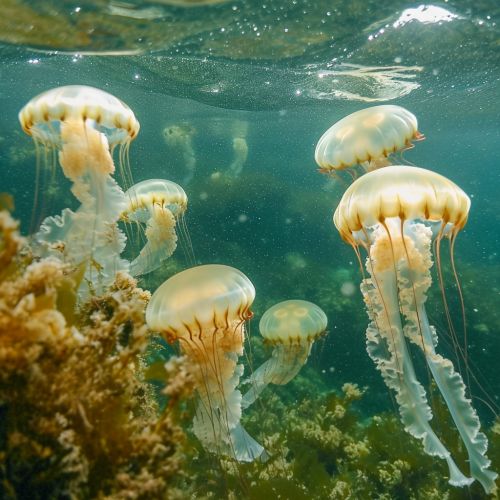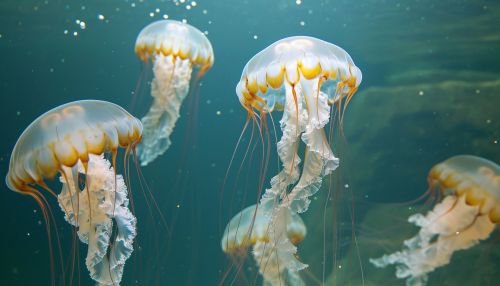Jellyfish bloom
Introduction
Jellyfish blooms are a natural phenomenon that involves a rapid increase in the population of jellyfish. This event can occur in any part of the world's oceans, and it is characterized by a high density of jellyfish in a specific area. Jellyfish blooms can have significant impacts on marine ecosystems and human activities, making them a topic of interest for marine biologists and oceanographers.
Biology of Jellyfish
Jellyfish, also known as medusae, are free-swimming marine animals that belong to the phylum Cnidaria. They are characterized by their gelatinous bodies and long, trailing tentacles. Jellyfish have a complex life cycle that includes both asexual and sexual reproduction. The life cycle of a jellyfish begins with a fertilized egg, which develops into a planula larva. The planula then settles on a hard surface and transforms into a polyp. The polyp can reproduce asexually by budding, producing more polyps or developing into a free-swimming medusa, the stage most commonly associated with jellyfish.


Causes of Jellyfish Blooms
Jellyfish blooms are typically caused by a combination of biological and environmental factors. These can include changes in water temperature, salinity, and nutrient availability, as well as the presence of suitable habitat for jellyfish polyps. In addition, human activities such as overfishing and pollution can also contribute to the occurrence of jellyfish blooms.
Environmental Factors
Changes in environmental conditions can significantly influence the occurrence of jellyfish blooms. For instance, increases in water temperature due to global warming can enhance the growth and reproduction of jellyfish, leading to more frequent and larger blooms. Similarly, changes in salinity and nutrient availability can also affect jellyfish populations. High nutrient levels, often a result of agricultural runoff, can lead to algal blooms, which provide an abundant food source for jellyfish.
Human Factors
Human activities have been linked to the increase in jellyfish blooms in recent decades. Overfishing can remove predators and competitors of jellyfish, allowing their populations to grow unchecked. Pollution, particularly in the form of plastic waste, provides additional surfaces for jellyfish polyps to attach and grow. Coastal development can also contribute to jellyfish blooms by altering natural habitats and creating conditions that favor jellyfish proliferation.
Impacts of Jellyfish Blooms
Jellyfish blooms can have wide-ranging impacts on marine ecosystems and human activities. They can affect the food web by competing with other species for food resources and by predating on fish eggs and larvae. Large blooms can also cause physical damage to fishing gear and can clog cooling water intakes of power plants located near the coast. In addition, jellyfish stings can pose a threat to human health and can negatively impact tourism in coastal areas.
Management and Mitigation
Managing and mitigating the impacts of jellyfish blooms is a complex task that requires a multi-faceted approach. This can include monitoring jellyfish populations, modifying fishing practices, reducing pollution, and restoring natural habitats. In addition, research into the biology and ecology of jellyfish can provide valuable insights into the causes and impacts of jellyfish blooms, informing strategies for their management.
Conclusion
Jellyfish blooms are a fascinating and important aspect of marine ecology. While they can pose challenges for human activities and marine ecosystems, they also provide opportunities for scientific research and can serve as indicators of environmental change. Understanding the causes and impacts of jellyfish blooms is crucial for managing these events and for maintaining the health and sustainability of our oceans.
